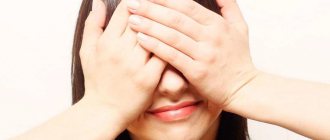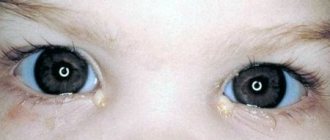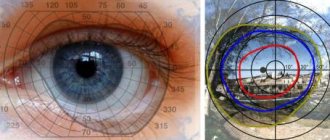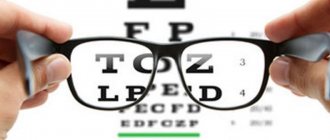Vision test Glasses for astigmatism Interpupillary distance Glasses prescription
Glasses can now be purchased anywhere, even on the train or at a clothing market, but despite the availability of such glasses, buying them “by eye” is an extremely dubious proposition. Even if you have a prescription from an ophthalmologist, it is impossible to ideally select glasses from a non-professional mobile ophthalmologist so that they correct your vision 100%. In order not to completely ruin your eyesight, before ordering glasses, you should definitely consult an ophthalmologist. Regardless of the cause of decreased vision, farsightedness or myopia, to select glasses you need to go to a medical clinic or an optical salon, where a specially trained specialist, an optometrist, will see you.
How to test visual acuity
Focusing only on subjective comfortable sensations, you cannot select glasses; before deciding to buy glasses, you must check your visual acuity. This is very easy to do with the help of an autorefractometer - a special device that is now even available in optical shops. With its help, a specialist can easily obtain basic information about the state of vision of a person.
It is worth noting that the information obtained from the results of autorefractometry is not enough to order glasses. Visual acuity is mandatory checked according to the table of signs, from a distance of 5 m. There are certain testing rules: the right eye is always checked first, while the left eye is covered with a special patch. The testing procedure is then repeated for the left eye. The essence of the method is to read letters in lines, starting from top to bottom. If the patient can read the last line in the table without errors, then his visual acuity is 100% and there is no need for correction. All other rows in the table reveal a discrepancy between visual acuity and the norm. For example, errors in reading the third line indicate that visual acuity is 0.3, the fourth - 0.4, and so on.
After the study has been carried out using the Sivtsev table, a trial frame with “minus” (divergent) or “plus” (collective) lenses is attached to the eye, in accordance with the data of the autorefractometer. If it is not possible to undergo autorefractomy, then weak diverging or collecting lenses will help determine visual acuity. They are placed on the trial frame one by one until the patient achieves the most comfortable vision. If autorefractometry was not performed, by placing a weak plus and minus lens, find out in which case the vision improved, and subsequently take stronger lenses of this sign.
As the optical power of lenses increases, their degree of refraction also increases. One by one, the lenses are carefully tried on until the maximum visual acuity is achieved for one eye. For those who have difficulty distinguishing objects in the distance (with myopia), a lens with a minimum refractive power is selected, at which visual acuity is the best. In case of farsightedness, on the contrary, a lens with the highest value is selected, at which the patient sees equally well both in the distance and near. Both eyes are individually corrected to 0.7 – 0.8. After this, the visual acuity of both eyes is checked simultaneously, i.e. binocular vision is determined. If the lenses for each eye separately were selected correctly, then the acuity of binocular vision should correspond to 0.9 - 1.0.
The same indicators for each eye are not always determined, although they are more common than different indicators of visual acuity. In case of differences in readings, the permissible difference between the visual acuity of the right and left eyes should not exceed 2-3 diopters. To choose the most comfortable glasses, you need to walk around in them for a few minutes and read, this way you can check the portability of the selected glasses.
Validation Rules
- 2.1 Video: Exercises to restore vision
In order for test results to be more or less reliable, certain rules are followed.
- The monitor is placed at a distance of 0.3–5 m, always at eye level, so that the surface does not reflect glare.
- Testing is carried out when a person feels well and does not feel tension in the eyes.
- Turn on general lighting.
- The verification table must be clear and contrasting.
- They sit straight, don’t squint, don’t strain their eyes.
- The test is carried out “with a fresh eye” - before going outside, reading, or other work that creates a load on the organ of vision.
Rules for testing vision using a computer
Sivtsev table
When people talk about checking their eyes, they remember, first of all, Sivtsev’s table. This is a poster featuring an array of capital letters that has 12 lines. Optotypes (as test letters are called) decrease from the top line to the bottom. On the left is the distance from which a person without visual anomalies should see this or that line. It is believed that normally the characters on the top line are distinguishable from 50 meters, and the bottom line from 2.5 meters.
The distance is indicated on the right in the table, and is designated by the letter D. And on the left side the value V is indicated - visual acuity. Usually, vision is checked from a distance of 5 m. For the purity of the experiment, the table is illuminated with a fluorescent lamp with a brightness of at least 700 lm. With normal vision, or V=1.0, a person sees the tenth line. If he recognizes only symbols located above, then they speak of myopia, below - about farsightedness.
Sivtsev table for vision testing
Visual acuity index V is determined when all or most of the characters in a row are read. When naming optotypes in lines seven to ten, you can make 2 mistakes, from lines four to six - 1 mistake. You can’t make mistakes when reading lines 1–3.
Orlova table for children
The vision of a preschooler who does not yet know letters is checked in a similar way. For this age, a special Orlova table has been created - it uses pictures.
Before the test, a little preparatory work is done with the child. He is brought to the table and the symbols are shown one by one. This is necessary in order to understand how the child uses the word when he sees a mushroom, a motorcyclist or a car.
Orlova table for children
In order not to tire the child, he is shown one figure in a row. Only if he does not recognize the picture is he asked to name the rest. Start from the first line, where the largest optotypes are.
Duochrome test
This test will help identify myopia and farsightedness. Distance glasses should not be removed if a person uses them in everyday life. The eyes are checked one at a time.
The duochrome test is carried out according to a table, the field of which is divided into two equal parts by a vertical line: the right one is colored green, the left one is colored red. In the middle of the field are letters.
Duochrome vision test
The purpose of the test is to determine on which color field a person distinguishes optotypes better. Its essence is outlined in the table:
| Background color to make letters easier to see | Mid-focus point location | Diagnosis, additional correction needed | What optics do you need? |
| Red | In front of the retina | Myopia (nearsightedness) | Minus |
| Green | Behind the retina | Hypermetropia (farsightedness) | Plus |
If the test is performed with glasses, then lens correction is necessary in accordance with the results obtained.
Patients with normal vision see the symbols on both sides of the table equally clearly. In this case they are said to have emmetropia.
Video: Duochrome test
Astigmatism
Refractive errors are called myopia, farsightedness, and presbyopia - senile farsightedness. All these visual impairments can be detected in the table below. However, it is interesting, first of all, because it is used to diagnose astigmatism.
Astigmatism occurs due to disruption of the shape of the eye lens. The disease is dangerous because it can cause the development of strabismus and a serious drop in visual acuity. At the first suspicion of such a disorder, you can use, for example, this table.
Table for testing vision for astigmatism
To check, you need to close one eye, move 3-5 steps away from the monitor, and look at the circle. A person with good vision has all the lines in the drawing of the same color and brightness. If the lines on the star become darker or brighter, astigmatism should be suspected.
Here is another version of verification images.
Option for astigmatism test images
Check the right eye, then the left eye. With normal vision, the lined squares are uniformly black. If some figures seem lighter, there are deviations from the norm.
Read more detailed information, methods for recognizing astigmatism, color blindness, farsightedness and other vision defects in our new article - “Vision Test”.
Siemens star
Interesting experiments can be carried out using a Siemens star. It is a figure consisting of 54 rays, painted black and connecting in the center, placed on a white background. The diameter of the circle is 10 cm.
The test taker moves away to a distance of 5 meters from the monitor. In the absence of anomalies, a person sees how, at half their length, the rays merge into a solid gray circle. This occurs because the retinal resolution has limits.
Siemens star
If refractive errors are present, then the picture is different:
- an inversion occurs: in place of the black beam there is a white background;
- the rays merge only for a very short segment, and then are distinguishable again;
- other effects.
All this can be seen by a person with normal refraction by bringing the picture close to his eyes.
Color vision test
Discussions about the color of the dress are still fresh in my memory: according to one version it was white and gold, according to another – blue and black. The controversy once again confirmed: not everyone perceives colors the same way. For example, some are not able to distinguish between shades of red - scarlet and wine. The reason for this phenomenon is that people have different numbers of photosensitive receptors (they are shaped like microscopic bulbs) in the retina of the eye.
This test was created by Diana Derval, a professor and neuromarketer. He will tell you how strong color perception is. The test subject is faced with the task of counting the number of shades that he can distinguish in the picture.
Diana Derval test
Explanation of test results:
| Result | Number of colors | Decoding |
| Dichromate | Up to 20 flowers, about 25% of the population | There are only two types of receptor bulbs in the eye. Such people usually prefer black, blue, beige colors in clothes |
| Trichromate | 20–32 colors, about 50% of the population | There are three types of cones in the organ of vision, thanks to which it is possible to see shades of blue, red, violet, and green |
| Tetrachromat | 32–39 colors, 25% of the population | In such people, all four types of photosensitive receptors are involved. But with such color perception, yellow is most likely annoying |
Amsler test
This is a simple and informative test that allows you to identify macular edema, metamorphopsia, and scotoma.
The picture is placed at a distance of 30 cm from the eyes, the right eye is covered, and the left eye is looked at for a few seconds at the black dot located in the center of the grid. Then the eyes change.
In healthy people, the lines should be smooth, without any spots or deformations. Curved lines around the point indicate that macular degeneration or other disorders may develop.
Amsler test
For reference:
- Macular edema is swelling of the macula (macula), the central area of the retina responsible for central vision. It contains many photoreceptors; disturbances in this part of the eye significantly affect the quality of vision and indicate serious diseases - diabetic retinopathy and retinal vein occlusion. Symptoms of edema: blurriness, distortion, pinkish tint of the image, increased light sensitivity, etc.
- Metamorphopsia is a distorted perception of shape, location in space, color, size, etc.
- Scotoma is the presence of “blind” areas in the field of vision that are not associated with the boundaries of such a field. Occurs with multiple sclerosis, damage to nerve fibers, blockage of retinal vessels, lack of nutrients, optic nerve atrophy, etc.
Video: How to test your vision without leaving your computer
Cataract test
This test can help determine whether people with cataracts need surgery. There are no graphic images, you just need to answer yes or no to the questions posed and calculate the results.
Cataract
- Can you read small print - in a book, on a label?
- Do you read without glasses?
- Do you easily recognize people when they come close?
- Do you see the edges of the sidewalk, the steps of the stairs?
- Are you able to read what is written on signs, street signs, public transport signs?
- Is small work easy for you – sewing, knitting, etc.?
- Can you see the TV picture clearly?
- Are you comfortable driving?
- Do you cook in the kitchen without using contact lenses or glasses?
If the answer to at least three questions from the list is negative, it may be worth thinking about solving the problem using radical methods.
Selection of glasses for astigmatism
If it is not difficult to choose glasses for nearsightedness or farsightedness, then this type of visual impairment such as astigmatism requires a more accurate and painstaking selection of spectacle lenses. For astigmatism, you need cylindrical lenses, which are quite difficult to get used to. If the patient suffers from a high degree of astigmatism, then at first glasses that are weaker than required are prescribed, but after about two months it will be necessary to choose stronger glasses.
In ophthalmology clinics, whose diagnostic complex includes a device called a phoropter, the lens selection process is much faster. If you have this attachment, a trial frame and a set of glasses are not required.
If glasses are selected for reading only, then a special table is used to test near vision. The scheme for selecting glasses according to the table for correcting farsightedness is no different from selecting lenses for distance. Similarly, each eye is checked separately, testing begins with the right eye, and when the diopters of the left eye are determined, testing of binocular vision continues. According to the patient’s needs, they are guided by the texts of tables from 4 to 6.
Vision problems can be so complex that both farsightedness and nearsightedness have to be corrected. In this case, you have to choose bifocal or progressive glasses. When calculating the optical power of these glasses, it is necessary to take into account the difference in diopters; for comfortable wearing, the optical power of individual zones should not exceed 2-3 diopters. It is important that for the selected indicators, visual acuity is sufficient.
Measuring the distance between the pupils
For 100% vision correction, the decisive factor is the correct fit of the glasses. To do this, the interpupillary distance is measured; in other words, the lenses in the glasses are centered. An experienced ophthalmologist can measure the distance between the center of the pupils using a very ordinary ruler, but now ophthalmologist's offices are often equipped with a special device designed to measure interpupillary distance - a pupillometer. It increases measurement efficiency several times. With any method of measuring interpupillary distance, it is important to remember that this indicator in distance glasses should be 2 mm greater than for glasses used for near reading. If these rules are not followed, incorrect alignment of glasses can cause not only visual discomfort, but also headaches, as well as decreased vision.
Prescription for glasses
The result of all measurements, selection of lenses and frames is a prescription for glasses, which takes into account all the individual characteristics of the glasses. This is an important document that must be written out by a specialist optometrist or ophthalmologist, because the prescription includes many special points that are difficult for a non-professional to understand. The following items should not be omitted from your glasses prescription:
- All patient data.
- The optical power of spherical or cylindrical lenses, with the obligatory indication of the cylinder axes.
- Interpupillary distance.
- Purpose of glasses.
- for home;
- for reading;
- for constant wear;
- for working on a computer or watching TV.
A prescription written by an ophthalmologist is a document, and even if you use glasses for a long time, you should not throw it away. If vision deteriorates or, conversely, improves, when it becomes necessary to prescribe new glasses, having a previous prescription in front of him, the ophthalmologist will be able to trace the dynamics of changes in vision.
It is extremely important that glasses are selected only by a highly qualified specialist, because ill-chosen glasses are likely to worsen existing visual impairments. Poorly chosen glasses can also cause rapid eye fatigue, headaches and eye pain, reduce performance and worsen the overall quality of life.
Trust your vision only to professionals!
You can make an appointment and ask clarifying questions to our specialists by calling 8 (800) 777-38-81 and 8 (499) 322-36-36 in Moscow (daily from 9:00 to 21:00) or using the contact form connections on the site.
Dagaev Adam Huseinovich
Low myopia
Myopia, or myopia, is a common vision defect that is associated with underdevelopment of the muscles of the eye lens. With this disease, light rays reflected from distant objects are concentrated not on the retina, as in a healthy eye, but in front of it, which leads to blurred distance vision. At first, mild myopia can be painless and unnoticeable.
According to the degree of development of the disease, there are: progressive and stationary myopia. With progressive myopia, vision deteriorates by more than 1 diopter per year. As the disease progresses, the internal membranes become elongated, leading to disruption of their structure and functioning. Such myopia can lead to irreversible processes, for example, leading to retinal dystrophy and detachment.
Note that there are three degrees of myopia:
- Mild myopia – up to 3 diopters.
- Moderate myopia – from 3.25 to 6 diopters.
- Severe myopia – over 6 diopters.
Causes of mild myopia
There are known factors influencing the origin of mild myopia, such as:
- Heredity - fifty percent of children whose parents have myopia have this disease, while only eight percent have normal vision of their parents.
- Lack of microelements in the body, such as zinc, manganese, copper and others.
- Violation of visual hygiene requirements, namely significant and prolonged eye strain, insufficient lighting, prolonged exposure to the computer.
- In addition, previous infections, birth injuries, hormonal imbalances, increased intracranial pressure, and cerebrovascular accidents have an adverse effect on vision.
Symptoms and diagnosis
The main symptom of myopia is a deterioration in distance visual acuity, objects appear indistinct and blurry. Symptoms also include rapid eye fatigue and headaches. Myopia usually develops and progresses during school years, due to increased load on the visual organs.
However, to make an accurate diagnosis, it is necessary to carry out ophthalmological tests, examination of the structure of the eye, ultrasound, viziometry, biomicroscopy, determination of refraction, and ophthalmoscopy.
Treatment of low myopia
To treat mild myopia (up to three diopters), the following methods are used:
Selection of glasses for vision correction. A negative lens focuses the image on the retina, thereby increasing the quality of vision. For mild myopia, you should not use glasses all the time, but seek their help when necessary. This is due to the fact that with glasses the eyes look only forward, and in order to look to the side, a nearsighted person has to turn his head. As a result, the peripheral eye muscles weaken, and myopia begins to progress.
Note that contact lenses are a good alternative to glasses for low myopia. When using them, correction proceeds more naturally, since the lens and pupil move together. This promotes the work of all the muscles of the eye, and there is no distortion in the size of objects known when using glasses.
One of the methods of treating low myopia is laser vision correction. During this procedure, a laser beam changes the shape of the cornea. Due to this, the image begins to focus on the retina, like in a healthy eye, and not in front of it, like in a myopic eye. Laser vision correction makes it possible to quickly and painlessly acquire almost one hundred percent vision.
In addition to all of these methods, doctors recommend doing special exercises every day that help improve blood supply to the muscles responsible for focusing vision. There are several methods in which sets of special exercises have been developed aimed at restoring vision (U.G. Betsa, M. Brofman, M. Norbekova, etc.).
Prevention
To prevent mild myopia, you must adhere to the following rules:
- Use properly fitted glasses or contact lenses.
- Take a complex of vitamins and microelements for the eyes, which include lute.
- Eat a balanced diet.
- Maintain visual mode. Do not work at the computer for a long time and do not get too carried away with watching TV. You should read while sitting at the table. The workplace should be well lit.
- Also, it is necessary to regularly perform eye exercises.
- Please note that if you have myopia, it is not recommended to engage in sports such as boxing, wrestling, weightlifting, jumping, hockey, etc.
- By following all these recommendations, you can not only stop the deterioration of your vision, but also completely restore it without resorting to surgery.










